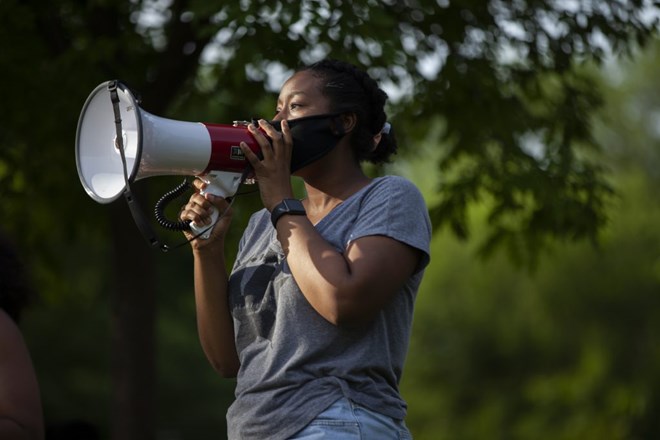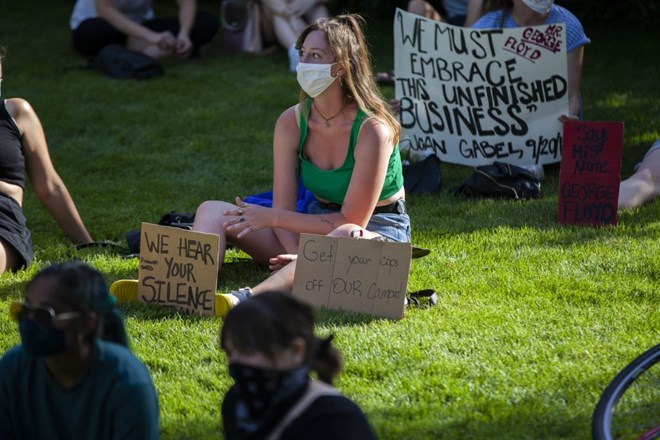
Saturday June 27, 2020
By BECKY Z. DERNBACH
Students want more money spent on mental health, trauma support and cultural groups; less on police.

Fanta Diallo, a 2020 University of Minnesota graduate, speaks at a sit-in to defund the university police department. Credit: Jaida Grey Eagle | Sahan Journal
Under a blazing afternoon sun, dozens of University of Minnesota students poured through the gate in a white picket fence and onto the lawn of the university president’s mansion overlooking the Mississippi River. They brought bottles of water, disposable masks, hand sanitizer, granola bars, a speaker to blast their curated playlist — and signs demanding the defunding of the university police department.
Thursday, the day of the rally, was exactly one month since Minneapolis police killed George Floyd.
“Nothing has changed,” organizer Fanta Diallo told the crowd through a megaphone.
“We’re the largest institution in the state of Minnesota and we are at such a perfect time to lead by example,” added Jaelah Lymon, a rising junior.
The University of Minnesota was the first institution to cut ties with the Minneapolis Police Department after the killing of George Floyd, sparking a trend that spread to the Minneapolis Public Schools, the Minneapolis Park and Recreation Board, art museums, concert venues, and law firms. Under guidance from President Joan Gabel, the university will no longer contract with MPD to provide additional law enforcement support at large events like football games or concerts. The move came after an open letter from Jael Kerandi, the school’s first Black student body president, called on the administration to sever ties with MPD.
newsinBut for some students, the university needs to do more. The university has its own police department of about 55 officers. For the past two years, students have been pressing the university to minimize the presence of the campus police department and disarm its officers. Now they see an opportunity to make their goals a reality.
“People need to know that it’s not just one police department,” Fanta said in an interview. “It’s all police departments. This is a system that’s been corrupted.”
In the last few weeks, the group has settled on specific demands that include: minimizing the presence of officers in cultural spaces for students of color; reallocating $3 million of UMPD’s budget to mental health, trauma support, and cultural groups; creating an accountability council comprised of elected students and community members with power to oversee the department; and removing lethal weapons from officers’ daily uniforms. Organizers are not demanding the full dismantling of the university police department.
Last week, organizers presented their demands to Gabel on a Zoom call. But their frustration with what they view as her inaction led them to host a sit-in on the president’s lawn this week. Gabel’s office did not respond to Sahan Journal’s request for comment.
Olivia Crull, an organizer with Students for a Democratic Society who graduated from the university this spring, said the campaign to disarm UMPD began in the spring of 2018. It was around the time of March for Our Lives, the national student-led movement for gun control in the wake of the massacre at a Parkland, Florida high school. Since the only guns the students saw on campus were on UMPD officers, disarming them seemed like a logical step in the gun-control movement, she said.
Then that spring, an incident at Somali Night sent shock waves through campus, dramatically shifting how some students saw the university police department.
“Somali Night was really the impetus” for the campaign, Olivia said.
Somali Night, an annual family-oriented showcase of cultural heritage including music, dancing, and fashion, drew about 2,500 attendees that year. When the event concluded, guests were met with a heavy police presence outside the Northrop Auditorium from multiple departments, including both UMPD and MPD. A statement from the Somali Student Association said that officers formed barricades that prevented people from leaving or gathering their belongings, pushed attendees to the ground with bikes and batons, pulled a woman by her hijab, and maced children between the ages of 14 and 19. “Children were so negatively affected by the mace that they ended up vomiting,” the statement said.
A university spokesperson at the time said the officers were called to break up a large fight, as well as assist with an assault and a robbery. The spokesperson confirmed the use of a chemical irritant.
The Somali Student Association disputed the university’s account, saying there were only small fights and that officers did not help break them up.
“That was one of the first times on campus I felt like UMPD was very much not on my side, and on the side of trying to oppress and intimidate people of color, specifically Black and brown bodies,” Fanta said. “I think the reason that was a catalyst is because we finally got beyond just individual stories of people saying they feel uncomfortable with the UMPD. We started seeing it from a larger scale, and I think the true colors of why the system is bad started to show.”
Sumaya Mohamed, a marketing major who is the acting president of the Al-Madinah Cultural Center, which promotes understanding of Islam, said she’s noticed UMPD shadowing many events with large numbers of students of color, especially Black students.
“It’s crazy because you wouldn’t see it at any white events that might happen,” she said.

A student sits on University of Minnesota President Joan Gabel’s lawn during a sit-in Thursday, surrounded by signs asking Gabel to take action. Credit: Jaida Grey Eagle | Sahan Journal
Sumaya’s student activism started when she was in high school in St. Paul, organizing to remove police officers from schools. This multi-year campaign culminated in a victory earlier this week when the school board voted to stop negotiations with the St. Paul Police Department and develop alternative school safety strategies.
UMPD’s interactions with students create a hostile environment, and its presence in Cedar-Riverside, home to the university’s West Bank campus and a large Somali population, causes tension in the neighborhood, she said.
Fanta came to south Minneapolis from the West African nation of Guinea with her family as a young child, and grew up blocks from where George Floyd was killed. His killing literally hit close to home, she said.
Days after Floyd was killed, dozens of UMPD officers with weapons showed up to a student protest, only reinforcing the students’ resolve to call for disarmament. Fanta described the officers as wearing “full-on military gear.”
“It’s very disappointing to see a group of police officers who say they want to protect us clearly antagonizing students,” Fanta said.
Students say some of the funding currently allocated to UMPD should be diverted to mental health and trauma support services.
University data shows that students who experienced sexual assault or misconduct were significantly more likely to contact Boynton Health or the Aurora Center, a university service that supports survivors of sexual violence, than either UMPD or MPD.
“So if we’re seeing that these are the places that are actually helping students, actually making them feel safe, actually teaching them how to cope with their traumas, then why aren’t we funding that?” Jaelah said at the rally.
Students vowed to return to Gabel’s neatly manicured lawn if their demands were not met.
“It’s not just one cop and it’s not just one precinct. It’s all of them,” Fanta said. “Until we start having a national conversation on what policing needs to be and how we can change it, nothing else matters.”